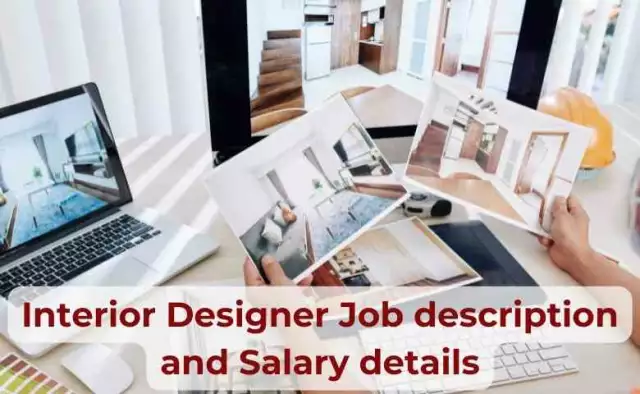Interior Designer Job description and Salary details
Interior Designer Job description and Salary details
Last Updated on May 27, 2022 by Admin
Interior design is a unique professional path since it involves bringing an artistic vision for work and living spaces to life and seeing a project through from conception to completion. Safety and functionality should be considered in design considerations, as well as rigorous adherence to construction codes and regulatory norms.
Interior designers that are able to think imaginatively about the use of space, color, and movement will draw inspiration from various artistic mediums. They’ll also be persuasive communicators when it comes to communicating a design concept.
Interior and spatial designers use their artistic abilities with their technical knowledge to create and renovate interior spaces and structures. Interior and spatial designers work on the design or remodeling of interior spaces, which may include structural changes, furnishings, fixtures and fittings, lighting, and color schemes.
You could work in a variety of contexts, including commercial, recreational, and residential. The position requires an awareness of aesthetics as well as effective and functional space utilization. Some interior designers, particularly in the domestic market, are only concerned with the aesthetic of the interior rather than the structure.
How to become an Interior Designer?
Interior designers work on architecture and interior space planning for a variety of clients, creating cohesive and visually acceptable solutions for homes and businesses. Many interior designers specialize in certain design sectors, such as home design (down to individual rooms), corporate office spaces, commercial interiors, environmental design, or accessibility requirements.
(adsbygoogle = window.adsbygoogle || []).push({}); Interior design and interior decoration are commonly misunderstood, yet they are two very separate vocations. While both seek to make places feel coherent and beautiful, interior decorators focus on enhancing existing areas with furniture and other home decors (for example, updating an outdated room with a new rug), whereas interior designers focus on creating the space itself.
While there is no one-size-fits-all technique to becoming a professional interior designer, most people take the following stages to get started:
Develop your eye: You can develop your eye at any age, whether you’re just starting out in design school or later in life. Being acutely aware of your environment is the most crucial aspect of establishing a sharp design sensibility: pay attention to graphic design, clothes, architecture, and landscape design. Everything has sentiment and purpose. Bookstores, museums, art and furniture galleries, vintage markets, and clothing stores are all excellent places to start forming strong ideas about the types of design you’re naturally drawn to—bold, muted, whimsical, traditional, and futuristic.
(adsbygoogle = window.adsbygoogle || []).push({}); Study interior design: Most organizations require interior designers to have some formal education—at least a bachelor’s degree, but depending on the firm, it might be as little as an associate’s degree or as much as a master’s degree. While relevant fields like architecture or design theory are preferred, don’t be discouraged if you’re getting a degree in anything else—consider taking some design-related coursework (such as fine art, art, and design, computer-aided design, or color theory) to round out your studies.
Seek formal training: Once you’ve completed your degree program, it’s time to start looking for experience-building job opportunities so you can start creating your portfolio. Before you can formally advertise yourself as an interior designer, you’ll need at least two years of full-time, on-the-job training and experience, so look for design employment like internships, apprenticeships, or entry-level jobs at interior design businesses.
Obtain a license: After completing your education and gaining two years of experience, you can take the NCIDQ, which is the official standard for interior design in various parts of the United States and Canada. A NCIDQ certification will demonstrate to clients that you are competent and committed to the industry, making it an excellent starting point for an interior design career.
Join a firm or strike out on your own: Once you’ve obtained your license, you’re free to pursue any type of interior design employment you desire, whether it’s working for an established firm or starting your own small business and searching out new clients independently.
Downloads:
What does an Interior designer do?
An interior designer is in charge of the arrangement of a building’s or structure’s interior space. The interior performance of a room has an impact on the wellbeing, safety, and function of the design. An internal space could be a permanent structure or a moveable structure like a boat or plane.
(adsbygoogle = window.adsbygoogle || []).push({}); Interior design is concerned with the planning and organization of interior space, as well as first and second fix installation skills in areas such as kitchens, bathrooms, path-finding, and surfaces. It also includes the tasks of a ‘space designer,’ as they are known in some nations.
Interior designers determine space requirements and pick critical and decorative components, such as colors, lighting, and materials, to make interior spaces useful, safe, and beautiful. They must be capable of drawing, reading, and editing plans. Building codes, inspection laws, and other factors, such as accessibility standards, must also be understood.
To establish how interior spaces will function, appear, and be furnished, interior designers collaborate closely with architects, civil engineers, mechanical engineers, and construction laborers and helpers. Interior designers must be familiar with construction codes and inspection regulations, as well as read blueprints.
How To Market Interior Design
Although some sketches are done freehand, the majority of interior designers use CAD software to create their drawings. Interior designers frequently utilize building information modeling (BIM) software to create three-dimensional renderings that include construction features such as walls and roofs throughout the design process.
Many designers specialize in specific building types, such as residences, hospitals, or hotels; specific areas, such as bathrooms or kitchens; or a particular style. Some designers work for home furnishings stores, assisting consumers in selecting materials and furnishings.
Some interior designers create building and installation designs, blueprints, and drawings. Construction and demolition information, electrical layouts, and building permits are examples of these products. Interior designers may provide papers ranging from simple sketches to building schedules and attachments based on the preliminary design.
(adsbygoogle = window.adsbygoogle || []).push({});
Role and responsibilities of Interior Designer
Following are the major roles and responsibilities of the Interior designer:
(adsbygoogle = window.adsbygoogle || []).push({});
Top 105 Interior Design and Fit-out Companies India 2022
(adsbygoogle = window.adsbygoogle || []).push({});
Skills and qualities required to become an Interior Designer
To be successful in the field of interior design, individuals must possess a specific skill set. If you want to learn how to become an interior designer, enrolling in interior decorating courses will provide you with the necessary tools and expertise. Whether you have a natural talent for interior design or need to work hard to develop this skillset, you’ll need the following for a successful career:
A keen eye for detail and a creative mind
To begin, you’ll need to be quite inventive. You’ll be responsible for designing environments for a variety of clientele. While having a distinct point of view can be advantageous, you’ll also need to be extremely adaptive. To create unified rooms, you’ll need to pay attention to both the small details and the broad picture at the same time. While creativity isn’t the only need for this position, it is a must.
Recognizing trends
Trends change, and you’ll need to remain on top of them. You’ll stay current and in-demand if you can detect and predict trends. Furthermore, being able to recognize negative trends helps ensure that your career remains relevant for years to come.
Understanding of sustainable practices
Clients are increasingly requesting environmentally friendly features. If you plan to stay in the California area, you’ll need a thorough understanding of these preferred design aspects and technology. Clients will look to you to make the best decisions for them, therefore having this knowledge is essential for overall happiness.
(adsbygoogle = window.adsbygoogle || []).push({});
Excellent communication
As an interior designer, you’ll need to be able to successfully express your vision to your clients and listen carefully. You’ll also need to collaborate with contractors and other experts who will be accountable for putting your plans into action.
Ability to sketch and computer knowledge
If you’ve ever considered how to become an interior designer, you might imagine having to do everything by hand. Most interior designers these days utilize computer-based design programs to produce visual representations of their work, but the ability to create early sketches is also beneficial. You will be more valuable to your clients if you can use both ways. Clients, however, want to see 2D and 3D graphics of ideas in real life, thanks to the popularity of many home design TV shows.
Organization
To finish projects on schedule and on budget, an interior designer must be exceedingly organised. You’re unlikely to get repeat business if work takes too long or costs beyond what a client was promised. Designers must plan everything down to the minute and dollar. Although unforeseen delays and costs will inevitably occur, you must plan ahead of time to account for these occurrences.
(adsbygoogle = window.adsbygoogle || []).push({});
Essential qualification required for Interior Designer
As an interior designer, you will assist your customer in curating or renovating the interior spaces of buildings such that they are both useful and aesthetically beautiful. To improve a space, you might suggest wall colors, lighting, fixtures, furniture, and fabric. Alternatively, you could be in charge of structural design aspects such as built-in storage, staircases, and ceiling designs.
(adsbygoogle = window.adsbygoogle || []).push({});
Salary details of Interior Designer
Based on 172 salaries, an entry-level Interior Designer with less than 1 year of experience can expect to make an average total compensation of 232,966 (which includes gratuities, bonus, and overtime pay). Based on 845 salaries, an early career Interior Designer with 1-4 years of experience gets an average total salary of $294,934.
Based on 256 salaries, the average total income for a mid-career Interior Designer with 5-9 years of experience is $422,433. Based on 107 salaries, an experienced Interior Designer with 10-19 years of experience gets an average total salary of $634,092. Employees with a late-career (20 years or more) earn an average total remuneration of $1,186,436.
In the United States, the estimated total pay for an Interior Designer is $60,014 per year, with an average salary of $56,355. These figures indicate the median, which is the midpoint of the ranges calculated using our proprietary Total Pay Estimate methodology and data from our customers. The extra salary is anticipated to be $3,659 per year. Cash bonuses, commissions, tips, and profit-sharing are all possibilities for additional compensation.
Final Thought
Interior designers typically spend the first five to ten years of their careers honing and expanding their skills and knowledge while also acquiring experience. Moving from a larger consultancy to a smaller one can mean increased responsibility, while specializations and further professional certifications at the master’s or PhD level can improve your prospects of promotion.
As your career progresses, it’s critical to have a portfolio. This can help you advance inside a firm or consultancy, as well as attract new clients if you’re self-employed. The majority of well-known interior and spatial designers present their work to potential clients on the internet.
(adsbygoogle = window.adsbygoogle || []).push({});





![Formworker Job Description and Salary details [2022 Updated]](https://realiff.com/assets/uc/Post/6jvdRutQriFK/thumbnail_default.webp?Zd3pmFcpsd4j)